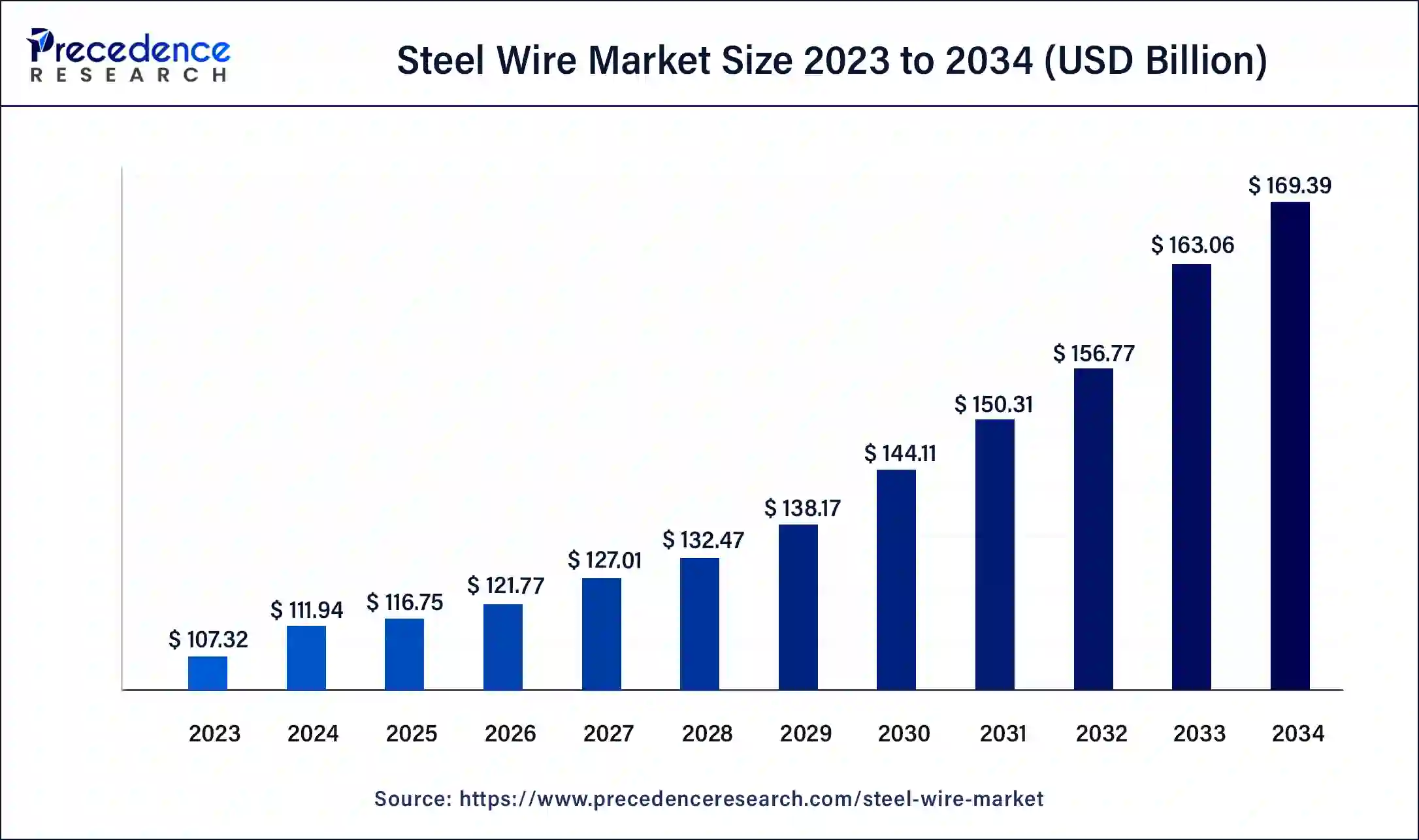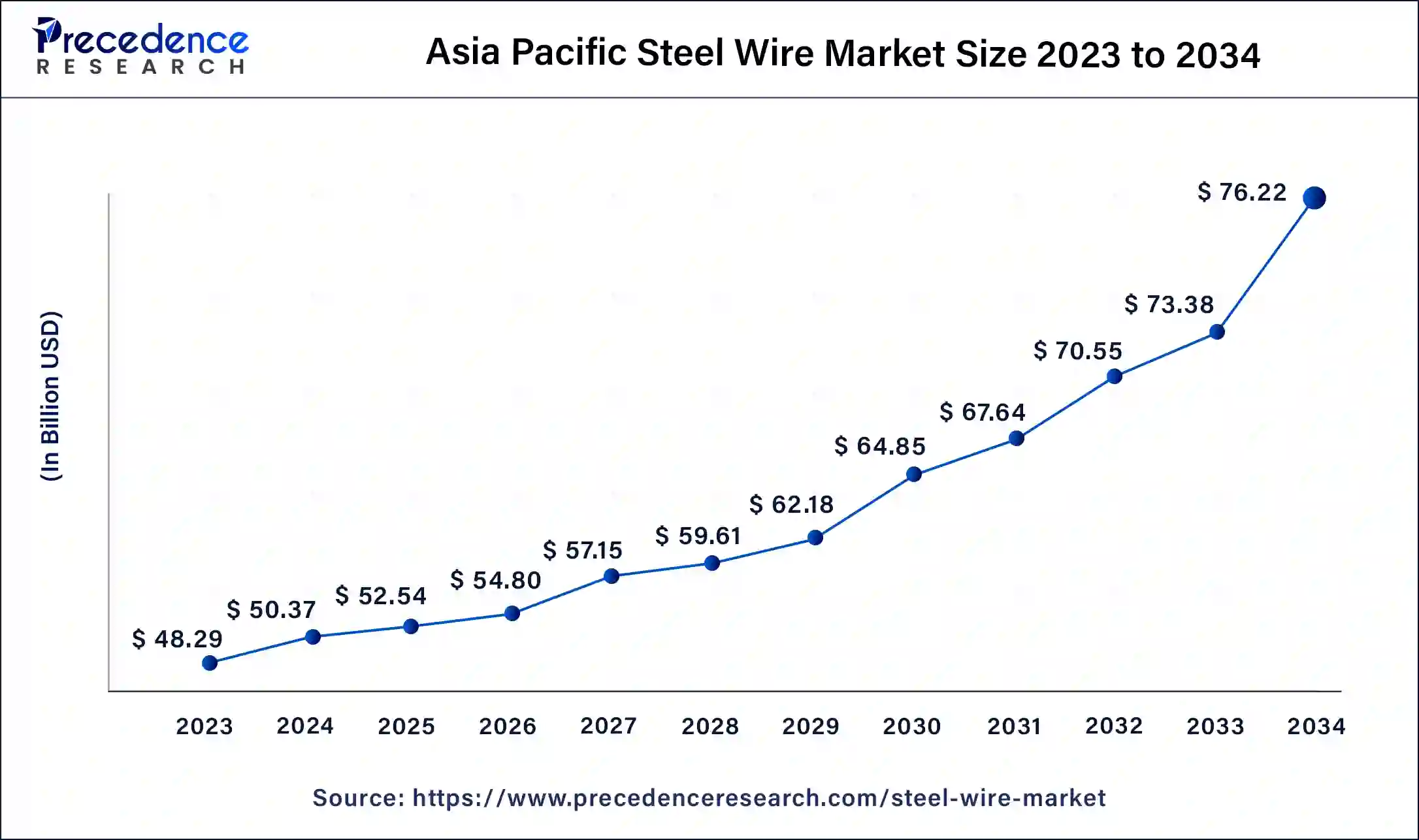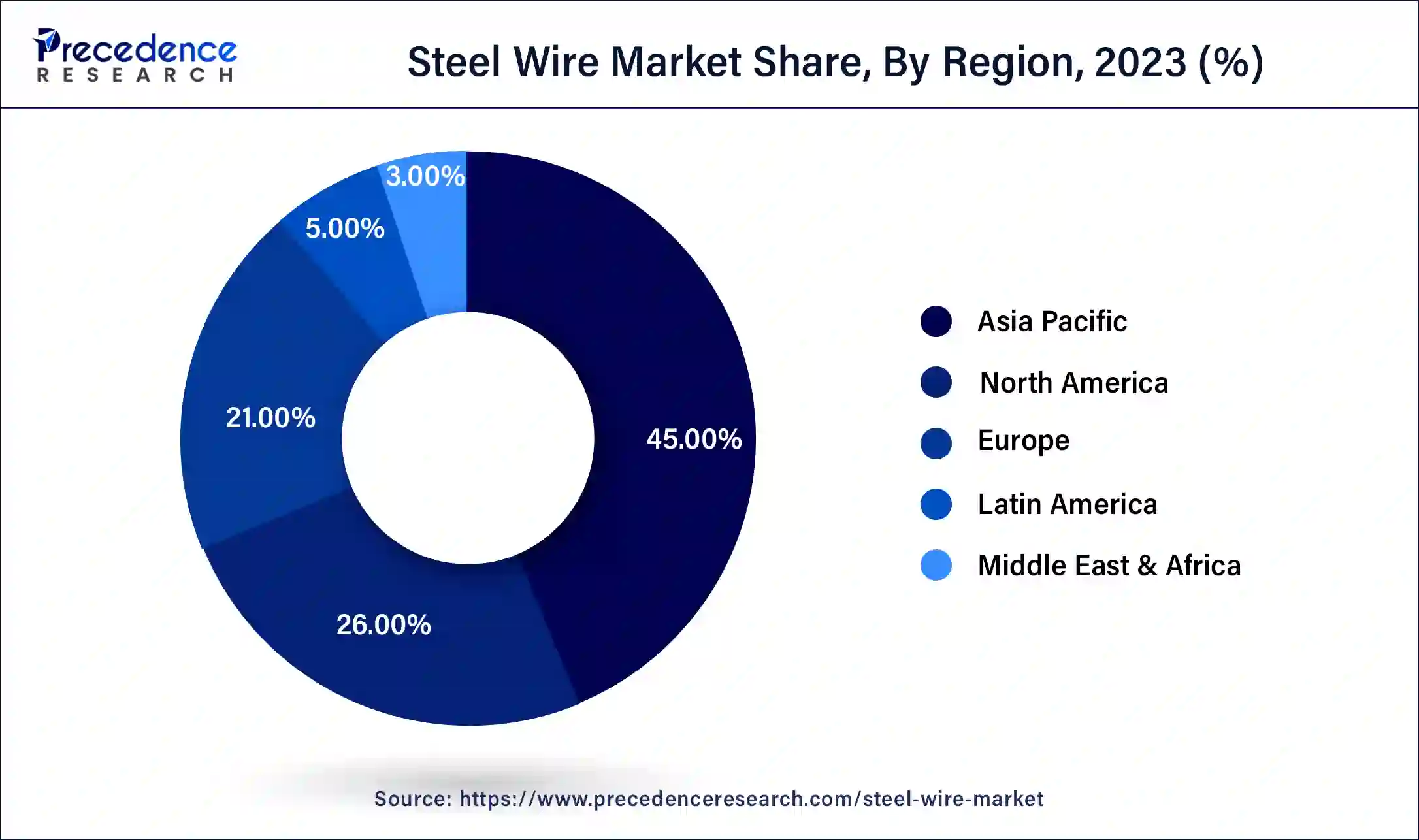September 2024
Steel Wire Market (By Material: Carbon Steel, Stainless Steel, Alloy Steel; By Application: Construction, Automotive, Energy, Industrial, Agriculture, Others) - Global Industry Analysis, Size, Share, Growth, Trends, Regional Outlook, and Forecast 2024-2034
The global steel wire market size was USD 107.32 billion in 2023, accounted for USD 111.94 billion in 2024, and is expected to reach around USD 169.39 billion by 2034, expanding at a CAGR of 4.2% from 2024 to 2034.

The Asia Pacific steel wire market size was estimated at USD 48.29 billion in 2023 and is predicted to be worth around USD 76.22 billion by 2034, at a CAGR of 4.4% from 2024 to 2034.

Asia-Pacific has held the largest revenue share 45% in 2023.
North America is estimated to observe the fastest expansion.

Market Overview
The steel wire market is a dynamic global industry centered on the production, distribution, and trade of various types of steel wires. These wires serve as indispensable materials with versatile applications across sectors like construction, automotive, manufacturing, and infrastructure development. This market's dynamism is chiefly influenced by factors including industrial demands, technological innovations, and economic conditions, making it a multifaceted arena for businesses and investors.
Several key trends and growth drivers are propelling the steel wire market forward. First and foremost is the ever-growing demand for steel wires in infrastructure development projects worldwide. This surge is attributed to the need for robust, long-lasting materials, particularly in rapidly urbanizing regions. Furthermore, the automotive industry's continuous expansion fuels the demand for steel wires, used in components like tire reinforcement and suspension systems. The advent of electric vehicles (EVs) is also a noteworthy trend, as they require specialized steel wires for batteries and other components. Additionally, technological advancements in steel wire production, such as high-strength wires for lightweight construction, contribute to market growth.
While opportunities abound, the steel wire industry also faces significant challenges. One of the primary concerns is environmental sustainability. Environmental regulations are becoming increasingly stringent, pressuring manufacturers to adopt eco-friendly production processes and materials. Moreover, market volatility due to fluctuating steel prices and global economic conditions poses risks to industry stability. Additionally, competition from alternative materials, like aluminum and composite materials, presents a challenge, as industries seek lighter and more corrosion-resistant options.
Despite these challenges, there are compelling business opportunities within the steel wire market. Companies can explore innovative recycling technologies to reduce waste and lower environmental impact, aligning with sustainability goals. As the renewable energy sector expands, steel wires are crucial for wind turbine production, presenting a growing market segment. Moreover, the escalating adoption of advanced manufacturing techniques, including 3D printing, may furnish fresh avenues for steel wire applications, particularly in aerospace and analogous domains. In conclusion, the steel wire market, characterized by its dynamism and adaptability, remains an essential player in the global materials landscape, boasting enduring relevance across various sectors.
In conclusion, the steel wire market is a dynamic and versatile industry with substantial growth potential. Industry trends are shaped by factors like infrastructure development, automotive demands, and technological advancements, while challenges include environmental sustainability and market volatility. Businesses can capitalize on opportunities by embracing sustainability, exploring emerging sectors like renewable energy, and diversifying into niche markets. Overall, the steel wire market remains a critical player in the global materials industry with enduring relevance across various sectors.
| Report Coverage | Details |
| Market Size in 2023 | USD 107.32 Billion |
| Market Size in 2024 | USD 111.94 Billion |
| Market Size by 2034 | USD 169.39 Billion |
| Growth Rate from 2024 to 2034 | CAGR of 4.2% |
| Largest Market | Asia Pacific |
| Base Year | 2023 |
| Forecast Period | 2024 to 2034 |
| Segments Covered | By Material and By Application |
| Regions Covered | North America, Europe, Asia-Pacific, Latin America, and Middle East & Africa |
Infrastructure development
Infrastructure development serves as a pivotal force propelling the expansion of the steel wire market. Across the globe, substantial investments by governments and private sectors in infrastructure projects fuel the surge in demand for steel wires. These wires, valued for their robustness, endurance, and adaptability, find indispensable utility in a diverse array of applications within the construction realm. They reinforce structures, ensuring the requisite structural integrity to withstand diverse loads and environmental conditions, facilitating the construction of bridges, buildings, highways, and railways. Moreover, the telecommunication sector relies on steel wires for the efficient installation of overhead cables and transmission lines, facilitating seamless connectivity.
With burgeoning urbanization and population growth, particularly in emerging economies, the imperative for novel infrastructure becomes pronounced, spurring heightened construction activities and consequently elevating the consumption of steel wires. Furthermore, infrastructure development acts as a potent economic stimulant, engendering a virtuous cycle wherein heightened economic activity begets more infrastructure ventures, thereby catalyzing and sustaining the upward trajectory of the steel wire industry.
Fluctuating steel prices
The erratic oscillations in steel prices present a formidable constraint on the growth of the steel wire market. These price fluctuations, driven by variables such as raw material expenses, global economic dynamics, and trade intricacies, introduce a level of uncertainty that hampers manufacturers' ability to plan production and pricing strategies effectively. When steel prices surge steeply, manufacturers grapple with heightened production costs, which can compress profit margins and erode competitiveness. Conversely, when steel prices plummet, manufacturers may witness reduced revenues even in the face of consistent or increased production volumes, creating financial instability. This rollercoaster ride in steel prices not only introduces market uncertainty but also disrupts supply chains, affecting inventory management and complicating the ability to meet customer demands in a timely manner. Consequently, the relentless volatility in steel prices serves as a deterrent to potential investors and poses a substantial obstacle to the sustained expansion of the market.
Renewable energy
Renewable energy is a significant catalyst for creating opportunities in the steel wire market. As the world accelerates its transition towards cleaner energy sources, the demand for steel wires has surged within the renewable energy sector, particularly in wind energy applications. Wind turbines, crucial for harnessing wind power, rely extensively on steel wires for their construction and operation. These wires are used for structural reinforcement, supporting the immense weight and forces experienced by the turbines. Additionally, steel wires are employed in the transmission of electricity generated by wind turbines to power grids.
As governments and organizations worldwide invest heavily in renewable energy projects to reduce carbon emissions and combat climate change, the steel wire market stands to benefit immensely. The continued expansion of wind energy, coupled with potential growth in solar power infrastructure, offers a promising avenue for steel wire manufacturers. Moreover, innovations in steel wire materials and designs tailored for renewable energy applications can unlock further opportunities in this evolving and environmentally critical sector.
According to Material, the carbon steel sector held a 63% revenue share in 2023. The carbon steel segment holds a major share in the steel wire market due to its widespread use across various industries. Carbon steel wires are known for their high strength, durability, and cost-effectiveness, making them a preferred choice in construction, automotive, and manufacturing sectors. Additionally, they offer excellent corrosion resistance when properly coated. Their versatility, coupled with competitive pricing, has contributed to their dominant market position. While specialty alloys and materials are gaining prominence, carbon steel wires remain a staple due to their reliability, meeting the diverse needs of industries, and maintaining a substantial market share.
The stainless steel sector is anticipated to expand at a significantly CAGR of 6.7% during the projected period due to its remarkable attributes. Stainless steel wires are prized for their outstanding corrosion resistance, rendering them indispensable in demanding settings like marine, chemical, and food processing industries. Their robustness and endurance ensure prolonged service life, making them a preferred choice across diverse applications, from construction to automotive components. Furthermore, stainless steel's aesthetic appeal and hygienic properties enhance its popularity in architectural and healthcare applications. Its adaptability, coupled with an extensive array of grades, solidify stainless steel's commanding position within the steel wire market.
In 2023, the construction sector had the highest market share of 35.8% on the basis of the Application. The construction segment holds a significant share in the steel wire market due to its wide-ranging applications in the construction industry. Steel wires are crucial for reinforcing concrete structures, providing durability and structural integrity in buildings, bridges, and infrastructure projects. The robust demand for construction materials, driven by urbanization, infrastructure development, and renovation projects globally, sustains the market's growth. Additionally, steel wires are indispensable in areas prone to seismic activity, further amplifying their importance in construction. As a result, the construction sector's reliance on steel wires cements its dominant position within the market.
The Energy segment is anticipated to expand at the fastest rate over the projected period. The energy segment holds a significant growth in the steel wire market due to its integral role in various energy-related applications. Steel wires are essential components in renewable energy sectors, especially wind energy, where they are used in the construction and reinforcement of wind turbines. Additionally, steel wires are crucial for power transmission lines, supporting the reliable distribution of electricity. The global shift towards cleaner and sustainable energy sources has fueled substantial investments in energy infrastructure, driving the demand for steel wires. This, in turn, has made the Energy segment a major contributor to the market's overall growth.
Segments Covered in the Report
By Material
By Application
By Geography
For inquiries regarding discounts, bulk purchases, or customization requests, please contact us at sales@precedenceresearch.com
No cookie-cutter, only authentic analysis – take the 1st step to become a Precedence Research client
September 2024
January 2024
January 2025
November 2024